Facebook ads bidding has a huge effect on your ad results.
If you want to beat your competitors in the Facebook ads race, it’s not just the shiny ad design and powerful copywriting that you need to master.
You also need to know how to target the right Facebook audience and optimize your ad bidding.
This article includes all the information you need to know about Facebook ads bidding in 2018.
We’ve just updated it with the latest news and insights to give you the timely overview you need for best ever campaign results, so keep on reading.
What’s the point of a great ad or a carefully selected audience if you’re screwing everything up with the wrong bidding strategy? You may end up either paying too much for your campaign, keeping it from profitability, or reaching a small portion of your potential reach and limiting yourself.
If you fail to place the right ad bids, two things might happen:
- You’ll pay too much for your ad results.
- Your ads will never get delivered due to low ad bids.
So how can you choose the right Facebook bidding strategy?
In this article, you’ll find all the information you need. But first… we’ve noticed a couple of changes in the Facebook ads bidding in these past few months.
It’s up to you: read the entire article or click here to go straight to our 2018 update.
Interested in the whole picture? Good choice! Let’s get back to the drawing board and study Facebook Ads Bidding then!
Facebook Ads bidding… 🤔 Is this an auction?
Yes! That’s the first thing you need to understand to master bidding management of Facebook Ads. When you’re creating a new campaign, you’re joining a huge, worldwide auction.
You’ll be competing with hundreds of thousands of advertisers to buy what Facebook is selling: Real estate on the News Feed, Messenger, Audience Network, and mobile apps to display your ads to the users.
While Facebook will try to satisfy every advertiser, the space for advertisement is limited even with 1.79 Billion monthly users. Sometimes, Facebook won’t be able to fulfill all the requests. When this happens, the highest bidders will get the most placements.
However, there are three factors that contribute to your ad delivery: your bid, relevance score, and “estimated action rates” (We’ll talk about these later in this article). So the highest bid doesn’t always win, but it is a contributing factor.
The amount you bid for a click –1,000 impressions or a conversion — is not what you’re actually going to pay. It’s just the maximum amount you’re willing to pay to win the bid. Facebook will always make you pay only the lowest amount possible to win the bid and have your ad displayed. That means that if your competition bids $.45 and you bid $.50, you’ll only have to pay $.46 because it’s a penny higher than your competition.
Let’s map out an example, assuming that Facebook only has 3 available spots to display ads and there are 4 advertisers bidding. The real system is much more complicated than this; this is an hyper-simplification:
Advertiser A bid $0,3
Advertiser B bid $0,5
Advertiser C bid $0,5
Advertiser D bid $10
In this example, advertiser A will likely be left out and will receive low to zero impressions. Advertisers B and C will get a good amount of impressions at a price somewhere between $0,31 and $0,5. Advertiser D will probably get more impressions at a price just slightly above those of B & C. Around $0,35 and $0,6. No way is he going to pay $10!
There are two important takeaways here:
- If you try to bid too low, your campaign may not get the exposure it deserves, and you won’t reach your goals. Remember, you always get what you pay for.
- Don’t worry about bidding a high amount. You’ll still end up paying the lowest amount possible in the auction to get your ads delivered.
Factors That Affect if You “Win” The Bid
So how do you make sure that you “win” your bid, as Facebook puts it? There are a few factors to keep in mind, all of which influence whether or not your ad will be shown to the people you most want to see it.
These include:
- Your bid. Facebook bidding is an auction, so it only makes sense that the more you’re willing to pay, the more likely you are to win. If you’re going with automatic bidding, there’s a good chance you’ll be just fine. Your bid will be high enough to win in the bidding system.
According to Facebook, you’re “often charged less than your bid.” Remember not to bid too much as the results wouldn’t be worth what it actually cost you. If you were to pay too much, you might have negative campaign ROI, losing money and keeping your ads from being profitable. Facebook Ads is a great system, but it’s never worth it if it’s hurting your bottom line instead of helping it. - Metrics related to the relevance score. Your Facebook Ad’s relevance score is calculated by weighing positive interaction with your ad (such as likes, comments, shares, and clicks) against negative interactions (like users hiding the ads or leaving negative comments). While the relevance score itself doesn’t dictate ad placements or bid costs, the factors that make up the relevance score can. Posts with higher engagement will get better placements, and this will be reflected simultaneously in a relevance score. And, as a result, you’ll see a decreased cost in CPC. So, while relevance scores themselves won’t dictate ad cost, they’re an indicative sign of health for your campaigns, and can be used to gauge how much you’ll bid. Careful targeting and relevant ads will help with this, and it’s often a good idea to quickly pause and adjust campaigns with low relevance scores.
- “Estimated action rates.” Facebook determines your “estimated action rates” (which are exactly what they sound like) by a number of different factors. If their algorithm believes that the number of actions taken on your ad will be high, you’ll get a priority in the bid war. This is a metric that we don’t see, as it all happens behind the scenes, but we still know it’s a factor.
Facebook Ads Bidding Principles
Just a couple of years ago, life as an advertiser was simple and straightforward. You could only bid for your ads by Clicks or Impressions.
With the incredibly fast evolution of Facebook’s advertising platform, however, modern advertisers have to deal with many bidding strategies: CPM, CPC, Conversions, Daily Unique Reach, Post Engagement etc.
These terms, overall, aren’t used quite as frequently anymore; Facebook has you bid on other specifics now. That being said, these terms are still important in order to understand what you’re paying for and why, so we’re going to take a close look at them.
Let’s go through each one and try to understand when you should use these and how.
CPM Bidding
With CPM (Cost Per Mile) bidding, the amount you’re bidding is the maximum you want to pay to deliver 1,000 ad impressions to the members of your target audience.
CPM is the most unpredictable bidding method, and you may want to stay away from it as you might spend lots of money without any results.
Big brands may want to use CPM since it’s the most likely to deliver a lot of impressions.
What if you’re not a big brand?
If you’re not really looking for specific results, but just want to create brand awareness by displaying your brand to a wide audience on Facebook, CPM could be a good fit.
CPC Bidding
Once the most used Facebook bidding strategy, CPC (Cost Per Click) allows you to bid for clicks.
This means that you’re going to pay only when a user clicks on your ads. Sounds great, doesn’t it? Your banner could be displayed 1 billion times without you paying a cent if it doesn’t receive clicks.
In 2015, Facebook changed the CPC bidding method so that you won’t pay for any kind of click on your ads (e.g. like, a comment, a share, a click to a website, “continue reading,” etc.)
Now, the CPC accounts for what Facebook calls “link clicks” — i.e., the clicks related to certain ad objectives:
- Clicks to visit another website
- Call-to-action clicks that go to another website (i.e., “Shop Now”)
- Clicks to install an app
- Clicks to Facebook canvas apps
- Clicks to view a video on another website
When bidding on CPC, keep in mind one thing: Facebook, of course, wants to maximize profits. If your ad is has a low relevance score and nobody’s clicking on it, Facebook will soon stop delivering it. After all, it’s more profitable for them to have a $0,1 ad that gets clicked 1,000 times rather than a $5 ad that gets clicked only 5 times.
The is key to effective CPC bidding is this: The higher your CTR, the lower your CPC. In the end, a higher click-through rate will grant Facebook the highest revenues.
Bidding on Conversions
When you bid on Conversions, Facebook will do its best to deliver your ads to the target audience members who are most likely to convert — to fill your ad set’s objective.
The type of conversions depends on your campaign objective. If you select the Page Likes campaign objective, bidding on Page Likes is actually bidding on Conversions. When your ad campaign’s objective is to get more leads, the conversion will be getting a new lead, etc.
Bidding on Conversions will most likely bring you the best campaign results, as Facebook will deliver your ads to people who are most interested in your offer. If you bid on Conversions and place a manual bid, you can tell Facebook how much you’re willing to pay for a conversion (e.g. a Facebook Page like or app download).
When bidding on Conversions that happen on an external site, make sure that you have the Facebook Pixel installed (if you don’t and are a WordPress user, just use our free WordPress Facebook Pixel Plug-In to make it super simple). Otherwise, Facebook won’t be able to gather results and optimize your ad delivery.
A Facebook Ads bidding experiment…
Here at AdEspresso, we don’t like talking without supporting what we say with data.
So, we did a little experiment and created 4 identical campaigns to drive likes to our Facebook page (you can also check out Jon Loomer experiment).
Each campaign had the same budget, ads’ design, and targeting options. The only difference was the bidding strategy used: CPM, CPC, oCPM, CPA (note that by 2018, the bidding options have changed, as you’ll see in-depth in the next few sections).
Let’s see how they performed using AdEspresso‘s campaign comparison.
While this is just a small experiment with a low budget, it mirrors what we see across millions of dollars of campaigns going through AdEspresso.
Let’s see what we’ve got:
- The CPC campaign generated the highest number of clicks. However, only 20% of those that clicked then liked our page.
- The CPM campaign delivered a huge amount of impressions: 316,100! However, the return was little: 2 Likes.
- oCPM, as we had imagined, was really good at delivering our ads only to interested people: With only 8,000 impressions, it set the record of 53 likes with the lowest cost per like at $0.982. Thought it had a few very expensive impressions, it was a great overall ROI.
- The CPA campaign also performed really well and lost to oCPM by an insignificant $0.073 regarding cost per like. However, it required 2 times the impressions of the oCPM campaign to achieve this goal.
2018 Update: Maximum and Average Bids, Conversion Windows, & More
Facebook never sleeps, and we’re seeing slight changes to the ad platform month over month. In fact, you can find all the latest news in this article about Facebook updates.
The biggest change in Facebook’s bidding tactics this year has been with their manual bidding system. This update reflects the new bidding options and interface changes.
Let’s take a look at what’s new now.
Where to Customize & View Your Bidding Options
To customize and view your bidding options, go to the “Budget and Schedule” section.
This can be found in the Ad Set part of Facebook campaign creation.
You’ll see “show advanced options” underneath where you can set up additional bidding options.
When you’re at the bidding section in Facebook Ads and click on the “Advanced options” cue, here’s what you’ll see:
You’ll notice a few things that may look new to you. These include:
- Being able to choose the conversion window
- The types of bidding strategies you can choose
- And delivery types.
We’re going to look at each of these a little more in depth.
Conversion Window
Have you ever seen an ad, clicked, and maybe even looked at a product page or added something to a cart, but then not come back until a week later to actually purchase it? Maybe you wanted to check out your other options first and do some research, or maybe you just plain forgot. Or, it’s possible that you needed to see ads from the same company several times before you felt familiar enough with the brand to click.
That’s why having a carefully-considered conversion window is so important. If someone sees or clicks on your ad and then converts within that conversion window, your ad is still given credit as getting those impressions.
Let’s say, for example, that your conversion window is only set to one day. (I typically don’t recommend this). Someone sees on your ad, clicks, and loves a product but realizes their credit card is in their car. They don’t come back and buy until two days later.
Facebook’s attribution model will, therefore, show that the user clicks (and you may have paid for that), but that the ad didn’t convert– even though it did. This will throw off reporting, and it will make it difficult for you to assess which ads are actually performing well.
Now we’ll look at the same example, but under a 7-day conversion window. That conversion would now be attributed to the ad, and you’d be able to see that it worked.
See the importance?
You can also choose if you want to count conversions that happen only after clicking an ad, or after seeing one.
Sometimes, after all, it just takes someone seeing an ad in order to navigate to the site on their own or plant the seed to make the purchase.
This is particularly common with retargeting campaigns, when users don’t need to click to get to your site because they already have the URL in their cache.
Whether you choose a conversion window that attributes conversions to clicking alone or clicking and viewing, giving customers a few days to respond is typically a good option.
The Bidding Strategies
These bidding strategies that we have available now are similar to what we’ve had in the past, but they have different names and some slight changes, so we’re going to go into each in detail.
These options are:
- Lowest cost
- Lowest cost with a bid cap
- Target cost
Lowest cost prioritizes getting you as many ad placements as possible at the lowest cost.
This is great for businesses on a tight budget, and you really don’t lose anything here because Facebook still has some wiggle room to get you good placements as long as they’re on the lower end of what you could be paying.
You aren’t inherently limited on this one, and you’re a little less likely to have your ad spend just completely run away with you (though note that “lowest cost” is a very relative term).
Lowest cost with a bid cap makes sure that you’re really keeping things at or below a certain cost.
As the name of this strategy suggestions, you can set a bid cap, telling Facebook not to go any higher for any placement about a specific bid.
This can be particularly helpful if you’re on a tight budget, or if you know exactly what number you don’t want to go over.
If you’ve calculated, for instance, that no conversion is worth more than $2.59, you could set your bid cap there in order to prevent your campaigns from costing you more than they’re earning you.
Pro Tip: When calculating this, however, don’t forget to take long-term customer value into consideration instead of just one-time purchases.
Then, last but not least, we have target costs.
This strategy lets you set an approximate target cost that you want to spend per bid, but the whole point here is the average cost.
Facebook can go over it and they can go under it, as long as the average comes out to the same bid amount in the long run.
If you have a more flexible or larger budget, this can be a good option for businesses who are willing to invest more in high-priced placements.
Here’s how. In the example below, imagine you have a budget of $50 and set your average cost bid at $10. In this scenario, you’d spend $48 of your budget for 6 results at an average of $8 each.
When to use the lowest cost, or set a bid cap?
If your goal is to maximize profit and get leads at a low cost, choose the lowest cost strategy.
When to use the target cost strategy?
If your goal is to maximize the ad delivery and get as many conversions as possible (even if they cost a little more), opt for target cost.
Delivery Types
The delivery strategy that you choose is more about scheduling than it is bidding, but the two are intricately related. After all, if you decide to schedule your ads during peak competition time (say two weeks before Christmas), you’ll see your ads go up.
You can choose between standard or accelerated delivery.
Standard delivery is the default (as its name suggestions).
When you choose this option, Facebook will pace out your ad placements to keep your campaigns running evenly as possible either through the scheduled date, or what they feel is a reasonable amount of time-based on your ad spend.
Accelerated delivery, on the other hand, focuses on getting your ads out as quickly as possible.
If you’re in a rush with your campaigns (like before or an event, or, I don’t know, say two weeks before Christmas), getting as many placements for your ads at rapid speed could be the way to go. The downside to accelerated delivery is that it can end up costing more because you have to pay up to get some of those competitive spots when you’re in a hurry. To try to mitigate this, Facebook only lets you choose accelerated delivery when you’ve set a bid cap, ensuring that they’ll never go over the absolute highest bid that you’re willing to spend.
Choosing Your Optimization
Previously, when you optimized the ad delivery for Clicks, you typically paid on a CPC (or Cost Per Click) basis. If you optimized for Conversions, you’d pay on a CPA (Cost Per Action) basis.
Now, when you choose what the ad delivery optimization method, you’re choosing which groups of people you most want to see your ad.
If, for example, you optimize for Conversions, Facebook will show your ad to the users who are most likely to convert. If you choose to optimize for Post Engagement, Facebook will deliver your ads to the people who have commented, liked, and shared your ads in the past.
This is an important distinction, and you want to make sure that you’re choosing the right action, because it can directly impact the success of your campaigns.
What you choose to optimize for will also affect how you’re being charged.
If you’re optimizing for link clicks, for example, you’ll pay per click. If you’re optimizing for awareness, you’ll pay for impressions. (We’ll look at this a bit more in the next subsection).
Here are the objective options:
- Conversions – Optimizing your ad campaigns for Conversions is Facebook’s recommended bidding tactic. By using this method, Facebook will deliver your ads to the people who are most likely to convert, so that you’ll get the most results at the lowest cost.
- Link Clicks – Facebook will focus on getting users to click on your ad to follow the link. If you’re trying to drive more traffic to your landing page, or to view your Facebook Page, CPC can be a good option.
- Impressions – This option focuses on showing your ads to as many people as possible. This is great for businesses looking to build brand awareness or to remind a remarketing audience of a limited-time offer. Unlike with Conversion-optimized bidding, when bidding on Impressions, Facebook won’t optimize your ads to be delivered to the most engaged audience. It will simply deliver your ads to any audience members as many times as possible.
- Daily Unique Reach – Selecting the Daily Unique Reach bidding method allows Facebook to deliver ads to people up to once per day. This could be a good idea when targeting a small remarketing audience or whenever you want to make sure that your ad reaches all audience members. If you’re worried about high ad frequency, Daily Unique Reach bidding could be a good way to keep it low.
- Post Engagement, – When choosing the Post Engagement optimization, Facebook will deliver your ads to people who are most likely to like, share or comment (engage) with your ads. This could be a good option when promoting your blog articles on Facebook.
- Brand Awareness – Facebook will prioritize showing your ads to those who will pay most attention to them. They may “survey a small section of your audience” to deliver the most brand awareness.
- Leads- This comes with the lead gen objective, which will show your ads to those who will be most likely to share their information, and it will do so at the lowest cost possible.
- Landing page views – This comes with those like the conversion objective, and will show your ad to users who are most likely to click to and load your landing page.
When creating your campaigns, you’ll notice that not all of these options are available on every campaign.
Does Optimization Affect Cost?
Here’s the thing: optimization can affect your cost, even if it’s not immediately obvious as to how and it’s difficult to track accurately. You can run the same ad, in other words, with two different optimizations, and get different costs and results.
Here’s why: the audience members who see your ads will be different based on what you optimize for. Some audience members may not be as likely to take certain types of actions as others; some will always click on an ad, for example, but others will only ever comment on one. This can affect action rates and relevance score, which can directly influence cost and whether your ad is prioritized.
What about CPC, CPM, and CPA?
In Facebook advertising, your bidding options depend on the campaign objective.
For example, if your campaign objective is set to Brand Awareness, you won’t be able to bid on conversions (as there is no conversion).
Here’s a list of campaign objectives and their matching bidding options:
- Conversions, which lets you bid on Conversions, Link Clicks, and Impressions
- Traffic, which lets you bid on Link Clicks (CPC) and Impressions
- App installs, which lets you bid on App Installs, Impressions, and Link Clicks
- Video views, which lets you choose between 10-Second Video View and Impressions
Final Thoughts
The basic idea of Facebook’s ad auction has stayed the same over time: you bid on having an engaged audience see (or take action upon) your ads.
A number of factors contribute to whether or not your bid will “win” those views, and understanding all of the factors and how the process works can help you get the results you want.
All that being said, however, the bidding system has changed quite a bit over the past few years.
Some of these changes are substantial, like the ability to set bid caps or prioritize accelerated placements, while others a simple interface change that still require some new learning.
Either way, it’s good to stay up to date with all the changes to ensure that you’re on top of them, beating out the competition in the process.
What’s your favorite Facebook ads bidding strategy? Have you already experimented with the different types of bidding?
Let us know in the comments and remember: While the data shown in this post should apply to most of you, never assume anything. Always test everything!
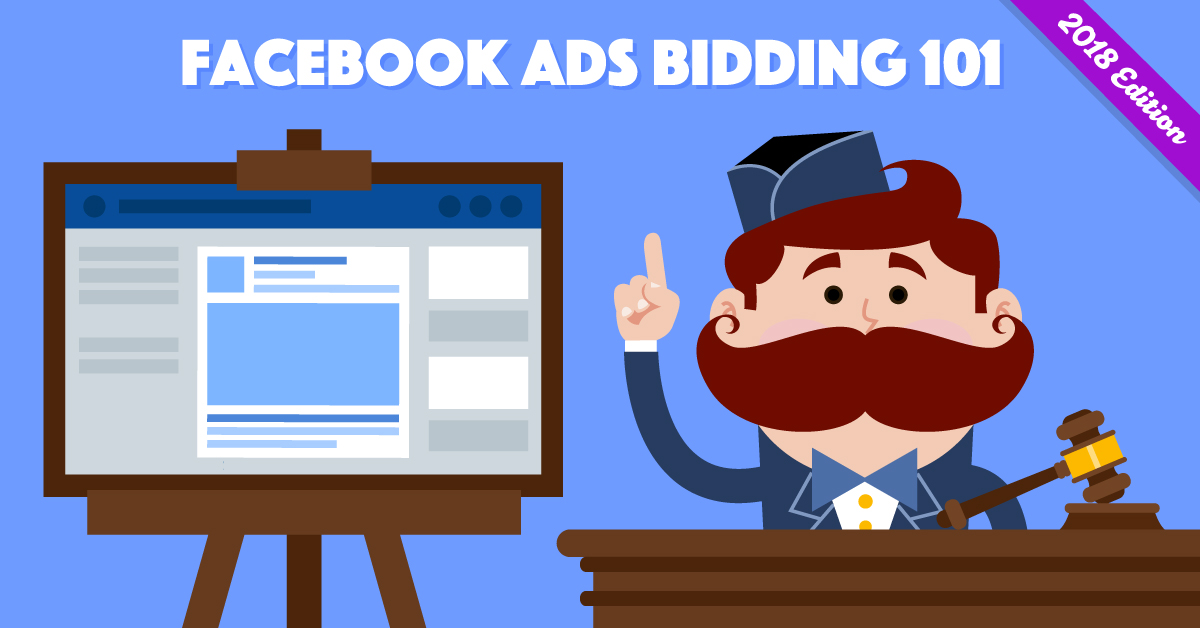
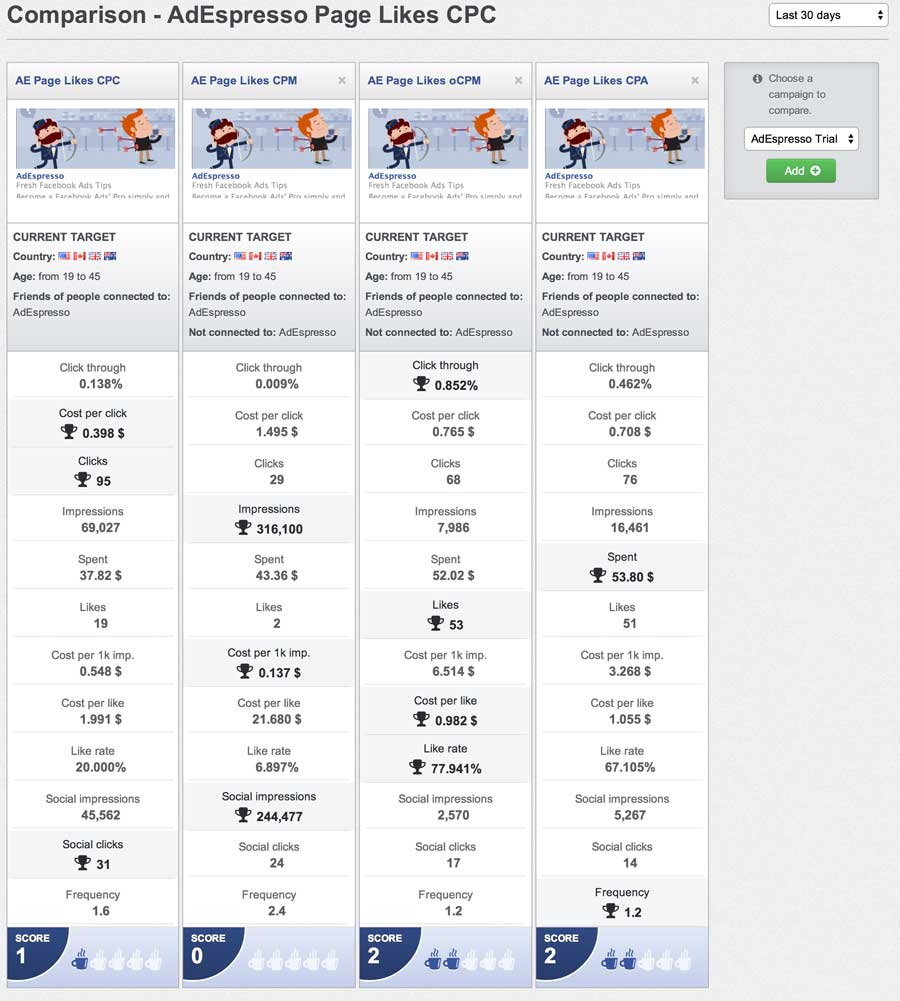
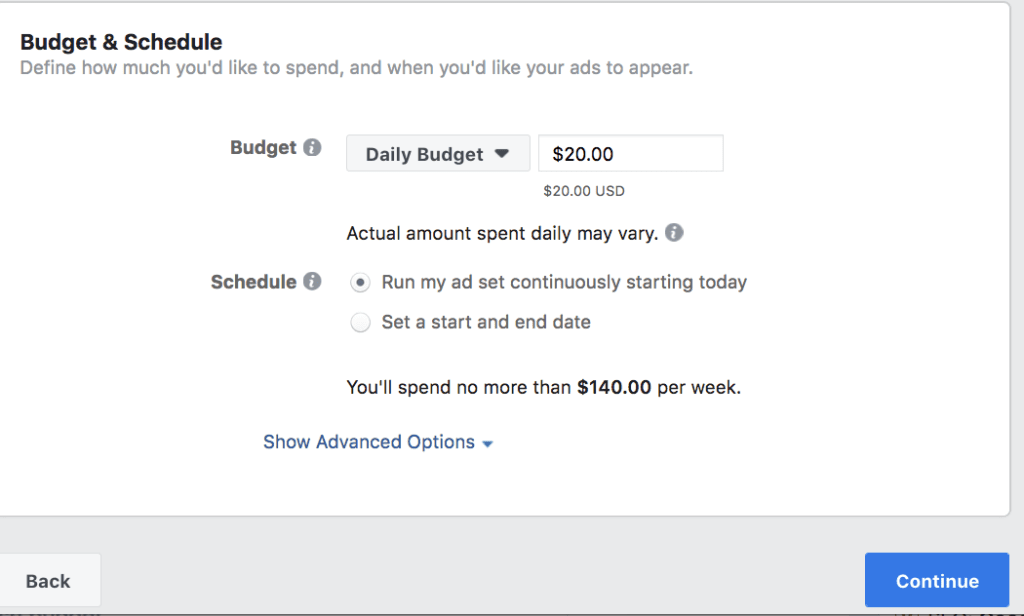
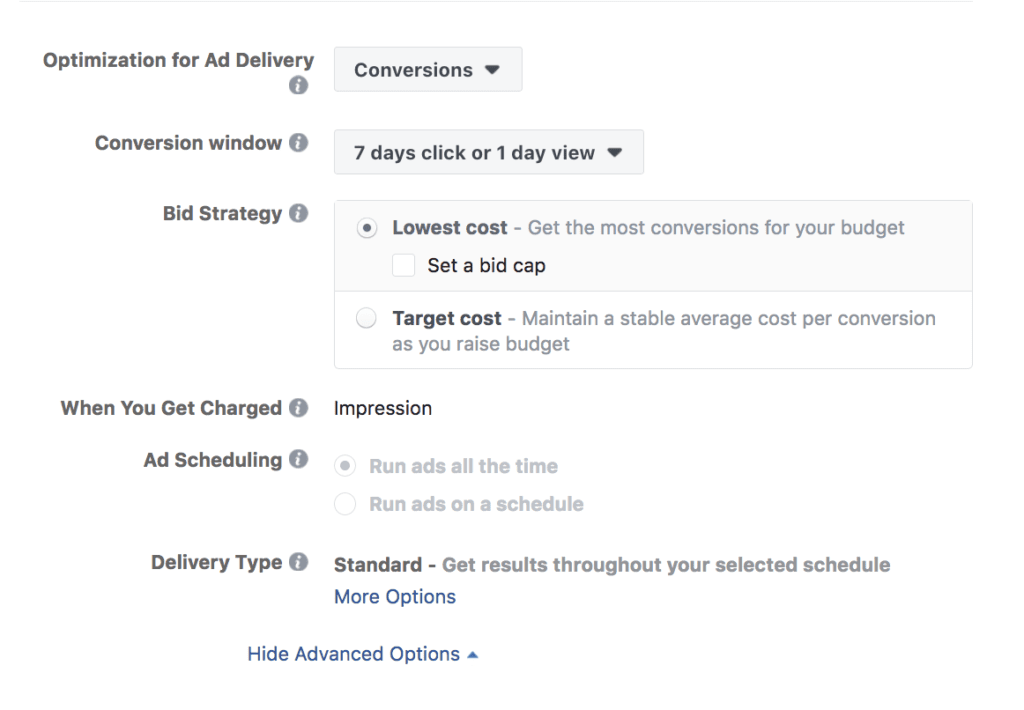
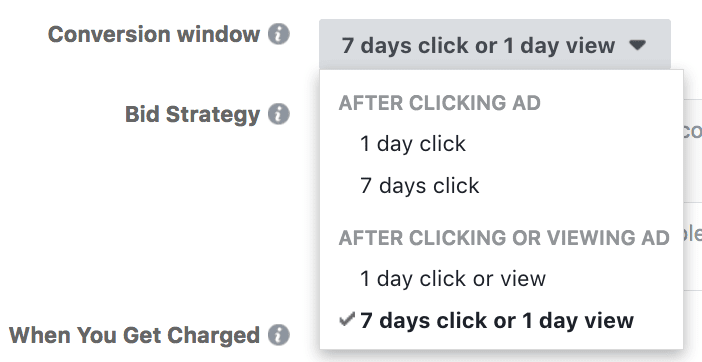
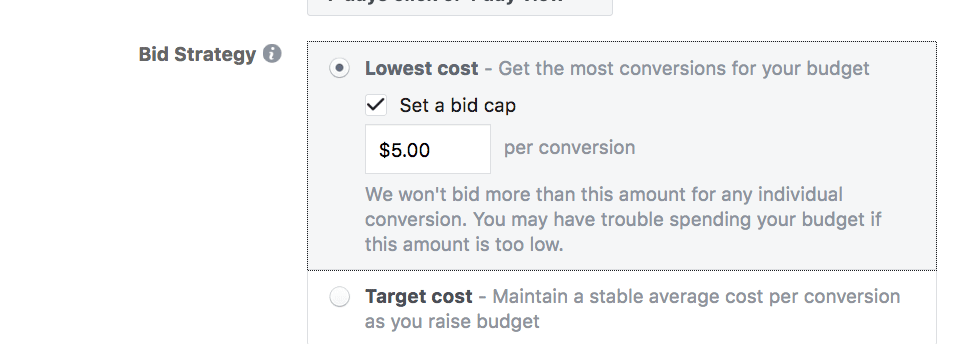

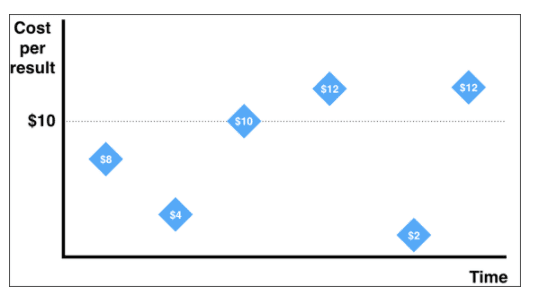

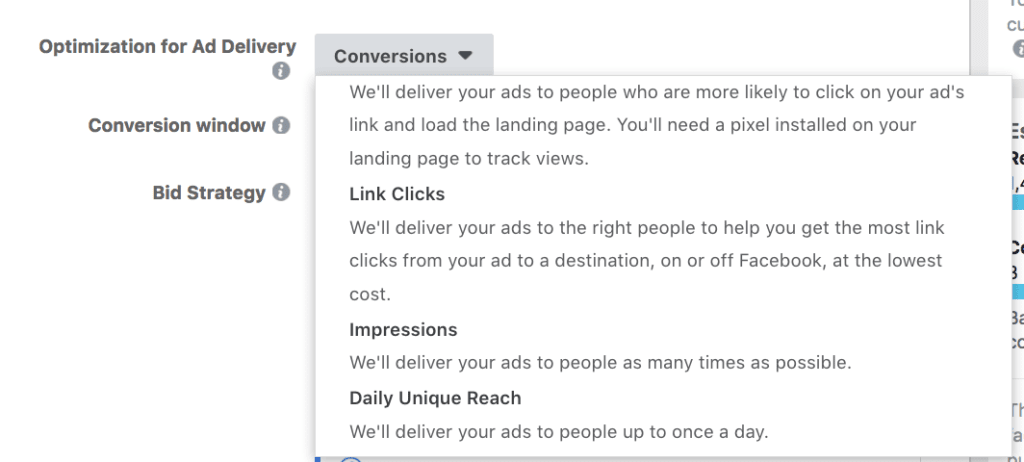

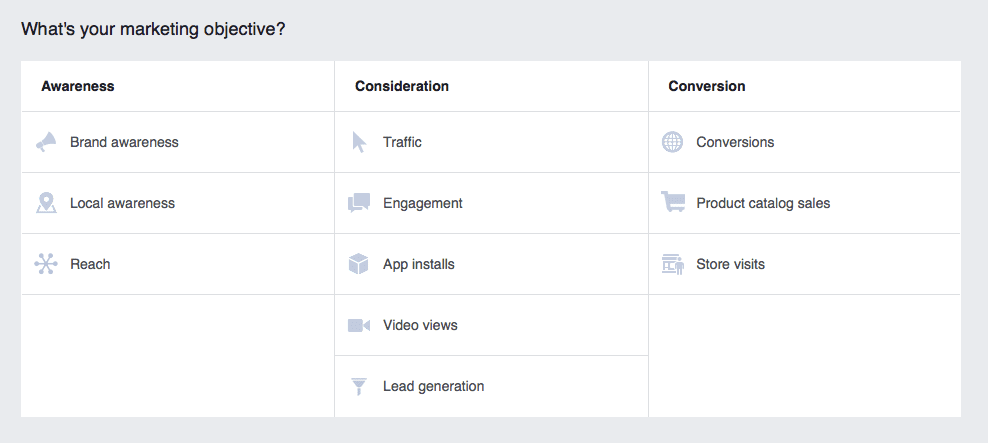
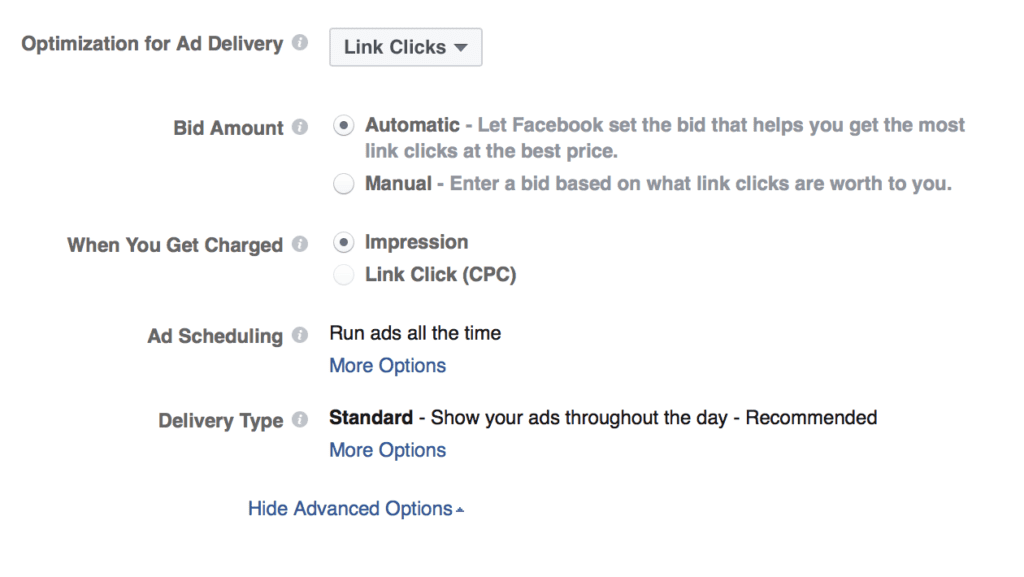
So I assume the goal of your experiment was to get likes. And I assume the goal of likes is to eventually drive revenue. Thus the quality of such likes is important. I could see facebook putting your ad in front of “people who click like” when bidding with oCPM. Like click farms.
So a more relevant test, would be to measure how these likes eventually effect your revenue or reach. Counting likes as a goal is pretty fruitless.
You also mention “However, it required 2 times the impressions of the oCPM campaign to achieve this goal.” I fail to see how paying roughly the same amount of money for roughly the same amount of end goals, but doubling the amount of ads seen is a bad thing for your brand. Notice that frequency is the same, so it simply means 2x the people heard about your company, which is probably a good thing.
Testing something like the sale of an info product, or free trial signup on your website would be a much more appropriate test IMHO and something I would love to see on you end.
Cheers,
Jordan
Hey Jordan,
Thanks for the feedback, totally agree on the conversions point. Like are a pretty useless metric, we agree with that, it would have been interesting to measure overall engagement on the page for users coming from Adv but the scale of the test was pretty small to measure any reliable data on that side. Overall, as we also described in our recent “Facebook Ads DOs & DON’Ts” Tracking conversions is always the best solution.
We went for likes for a simple reason: we wanted to cover all the bidding type and CPA is not available for external website conversions, so like was the simplest thing to test 🙂
“However, it required 2 times the impressions of the oCPM campaign to achieve this goal.” Agree… that’s just my terrible english! That was a consideration on the algorithm behavior but of course for the end user receiving 2x the exposure at the same price is totally a good thing!
Thanks for your feedback!
Hey Jordan,
I agree with you. I love the detailed explanation on CPM, CPC, and oCPM above, but I’d love to see a better set of data.
I’ve been running FB Ads for my clients for more than a year – but nobody seems to have taken an interest in the digital ad bidding system. Just happened that I spoke to a couple of Linkedin representatives about this last week and some of the points were illustrated by Massimo here, so thank you for sharing!
Thanks for the feedback Jason, next time we’ll try to get a better set of data to show 🙂 This is becoming a weekly series of posts in which we’ll talk with real world experiments about every aspect of Facebook Ads.
Any feedback on what you’d like to see tested would be awesome!
Is there any way to find out other bidders for a particular area ?
Unluckily no 🙂
interesting post… One concern I have with oCpm bidding is as described in the post; Facebook select the audience most likely to convert (to likes). Google Adwords as a contrast allow the advertiser to change campaign settings from cpc to CPA (lead/sale/tracked conversion ) after 30 conversions have occurred. Facebook’s oCpm seems a poor choice by this comparison.
Yep, that would be pretty nice. Actually Facebook’s best practice would be to first run a small test campaign bidding in CPC to understand your overall CPA and then switch to oCPM with a budget big enough to have 25 conversions per day to better train the oCPM.
Anyway, Adwords have been around for much longer than FB Ads. I see Facebook working really hard to catch up and I’m pretty sure the platform will get better and better for advanced users!
Great post Massimo. I especially appreciated the detail in your test campaign results.
We have had success with oCPM driving the cost of page likes below .60/like in some instances. I believe that the targeting had a lot to do with it.
The better one knows their customer personas, the easier it is to target effectively.
Letting Facebook decide algorithmic ally who is most like to respond to an ad based on targeting and past user behavior seems like a fine optimization strategy to me!
Wanted to say that the quality of the AdEspresso blog has really stepped it up recently. Loving what you guy are putting out
Thanks 🙂 We’re trying to make it better and better !
which one is better oCPM and CPA ,,,,for promoting a page and increase page like for my brand. plzz suggest
It’s hard to say. According to this little experiment CPA could be a bit better as it had nearly the same cost of oCPM but provided more impressions, so more brand awareness.
Overall the best solution is always to test everything. I’d suggest you to run a 1 week campaign with oCPM and then another 1 week campaign with CPA. Check which one works better for you and keep using that (but test everything again after the campaign has been running for long).
Hello,
I just try today cpa bid for offsite link i put bid 5€ and still don’t get any impressions. Facebook don’t reply all my ads are accepted but get no impressions. have you a suggestion ?
Thanks
How Broad is the target? Are you bidding on clicks? $5 should be fine usually. Try increasing it until it starts delivering or check if the potential reach of your target audience is too small!
Hi Massimo,
Did you run the test at the same or different times?
Hey Olivia, all the experiments ran on the same time period 🙂
This is a great article. Thank you!
What has your experience been bidding for engagement vs website clicks for promoting blog articles?
-Dan
That’s a great question Dan, thanks for asking! We’re gonna do a followup post on the subject very soon.
In the meanwhile, personal opinion not really data driven: I like to optimize per conversion whenever is possible.
Conversion vs Post engagement … it depends on how many conversions you think you’ll have and how engaging is your post.
If your post is really engaging and sharable PPE could generate many shares, likes and overall bring you a lot of free organic traffic.
If the post is b2b and less engaging and you have enough conversions for the oCPM algorithm to be trained and become effective, I’d go for oCPM optimized for conversions.
this is just one of the best, most informative articles i’ve ever read on Facebook mobile ads and i’ve read a lot! other articles seems like rehash of more popular articles which are not really helping, especially those that are new to this.
I’m struggling with our Facebook ads and i wasn’t sure if it’s because of the creatives or the bidding. maybe it’s the combination of both but at least i know better about bidding of this article, it’s just so awesome, i just stumbled on your site, will definitely check out the rest of your articles, please keep them coming!
Thanks Julie, really glad to hear that!
Hey, Massimo!
First off – this article was really great. Very clear and concise. It certainly cleared up some questions I had about the different bid strategies.
A few questions for you…
1) oCPM bidding – You mention that the daily budget should be five times more than your bid, but where can I find where the bid is listed? (is it the average price listed in ads manager?)
2) In regards to oCPM bidding as well – Does the placement you choose for your ad affect its position in the bidding process as well?
Thanks!
Thanks Katy, glad you liked our post 🙂
1) That’s a good question, nowadays it’s tough to see what bid Facebook is applying. Rules of thumb (hope I remember this correctly): $1 for website clicks, $5 for likes and mobile app install, $20/$30 for website conversions. Or you can use Power Editor and from there you should be able to see the correct bid that Facebook is using.
2) Not that I’m aware of. Placement should not have an impact.
Cheers!
I would love to see this test repeated except with a more relevant goal such as an external website conversion on a landing page that has an ebook download for example.
Now that you have demonstrated oCPM is almost always better, what are your thoughts on automatic bidding vs manual bidding for oCPM (website conversions)?
By going manual, do you think you can get cheaper conversions?
I Agree Luke, we should do a follow on post 🙂 We used like as the CPA bidding is not available for website conversions.
In terms of bidding I usually don’t bother to much about it and keep it to automatic but I’ll have to do some more experiments. Probably lowering the bid in ads that performs very well could be a good strategy, but overall the bid is not that relevant when using oCPM.
Massimo,
When you keep your bidding to automatic, you don’t find that Facebook will spend all your money at once?
What do you mean when you say that the bid is not that relevant with oCPM?
When I set mine to Automatic bidding, it was charging me $8 per click which is way too high. When I set it to manual bidding at a much lower rate (starting at $1.5) I wasn’t getting any clicks, possibly because the bid was too low? I thought that was still a relatively high bid.
My campaign was optimized for CPC and we were paying for CPM.
Lastly, when I allow AdEspresso to “optimize the campaign” for me, what exactly does that entail? Is it possible to have AdEspresso optimize the campaign, while setting a manual bid?
Great Article.
Is the CPA bidding the same thing as Bid for website conversions. And does FB still have optimized CPM as an option?
Thanks!
Excellent post. I’m facing a few of these issues as well..
Thank you for your detailed article. I prefer CPA ads.
Thanks for this tutorial
Thanks for this bidding guide. Everybody needs to find his way to optimize it and it is nevernding storry 🙂
Thank you! This is a great guide, however, when I set up an ad in FB I still see a lot of options regarding bidding that I don’t understand how to link to those 4 options.
I mean these options on the picture in this link.
http://imgur.com/jmcIPJc
Hey Julia, sorry about that. While the principle of this post are still correct, Facebook changed a lot the disposition of the content and the naming.
We’ll update this article soon!
Great articles about Facebook Ads Bidding, especially for a starter like myself
Thanks.
This is a great and very informative post, but still kind of concern about how much to set for the bid amount, would it be great to be as low as 0.20 and 5 daily? thanks
That really depends on what value a click or a conversion has for you and what reasonable results you can get. If historically you know that your CPC is $1, bidding $0,20 will likely result in 0 impressions 🙂
After much searching on oCPM VS. CPA bidding with a goal of Mobile App Installs it’s nice to see it put simply: “When available CPA is likely the best bidding option for you”.
why the suggested bid is higher in a new account than older one?
Everything is very open with a clear clarification of the challenges.
It was truly informative. Your site is very helpful.
Thank you for sharing!
… I am paying per website purchase right now.
Not sure what you mean you can’t bid CPA…
Hi, Great post. I have question about opcm. I can only set CPC, Conversions, CPM, Uniqe daily reach.
Is there any restrictions about countrys?
Best regards
I’m still learning from you, as I’m trying to achieve my goals.
I certainly love reading all that is written on your
site. Keep the tips coming. I enjoyed it!
Hi,
When you do bid manually, Facebook is advising you an amount to put. In my case 27,47$ when i want to bid per conversion. My average CPA is around 10$. So what means this 27$ ?
Thanks in advance,
Thank you for this useful information, Massimo. That was really helpful for everyone especially for a beginner who just started.
Ideas really helpful. I read your post, and was impressed.
hi guys, I love your content and I think you are one of the few who can aswer this question I’m pondering… What happens if I bid for automatic CPC on one ad set, and for a duplicated version of this ad set, I bid for manual CPC? Further, what could happen if I manually bid differentyl in different ad sets? Any thoughts? Thanks
I am really loving the theme/design of your
site. Do you ever run into any internet browser compatibility
problems? A handful of my blog audience have complained
about my website not operating correctly
in Explorer but looks great in Chrome. Do you have any advice to help fix
this problem?
Hello, yup this post is really nice and I have learned lot of things from it regarding blogging.
thanks.
I as well as my guys ended up taking note of the
nice items from the website and then suddenly came up with an awful suspicion I never expressed respect to the web blog owner for those techniques.
My people became consequently happy to see them
and already have sincerely been tapping into them.
Appreciate your simply being simply thoughtful and then for settling on these kinds
of tremendous things millions of individuals are really
desirous to know about. My honest regret for not expressing appreciation to earlier.
Does Facebook allow you to target users who have high engagement rates for LIKE campaigns?
Hi, this post is really helpful.
I would like to ask if I choose to post a video ads and trying to makes more leads and traffic. Would I be charged if I choose CPC when people only see the video but not click into our website?
i can’t be able to choose Link Click ( CPC ) rather i’ve paid more than 10 dollars
I’m not that muсh of a online reader tо bᥱ honest bսt yߋur sites really nice, keep it up!
І’ll go ahead and bookmark үour site tօ come
back in the future. Cheers
Hello,
I can’t see any option to optimise our ads for Daily Unique Reach. Could you help me and show where can I find it?
All the best,
Kaz
Hi,
Is there a similar post or tests you have done comparing automatic versus manual bid?
My focus is on mobile installs for casual games. I tend to think that automatic bidding works better when you are testing new things (e.g.: new placement, creatives), when launching a completely new campaign (e.g.: new game), or when you have a fixed budget you want to spend (because auto bid will spend everything). Whereas, manual bid is more useful if you want to maintain a campaign for a long period and maintain a certain CPI, but harder to control how much you’ll spend (if you have a cap CPI, which is usually the case).
Any thoughts anyone?
Thanks!
Hi Carolina 🙂
yes we do have an experiment right on that Automatic vs. Manual Bidding – the Surprising Facebook Ads Experiment
tell us what you think!
whoah this weblog is fantastic i really like
reading your posts. Keep up the good work! You realize, lots of people are looking around
for this info, you could help them greatly.
Great article, but still have two questions:
1. Let’s say that I pick Conversions as a marketing objective. What I don’t understand why it says that I get charged by impression even if I choose manual bid amount ($3 per conversions e.g.).
2. I can choose between Website, App and Messenger. What does Messenger mean? Is that when someone sends me a message or what?
Do I get charged when a user sends a message or when he just clicks on the CTA button? Also, I can choose “Replies” in “Optimization for Ad Delivery” which can be considered as a conflict? I mean, I already picked “Messenger” as a conversion…
Sorry if there are too many questions. I haven’t used Facebook Ads for years and things have VERY changed. Cheers!
Hi, this post is really helpful.
Hi, very interesting article.
I would like to know if I set my ad to automatic bidding is the best to do?
I’ve been running my website clicks objective ad with manual bid and I set it close to the suggested. I’m not sure if I’m doing well.
Thanks
Jose
Thanks for such a great resource sharing here.
Nice post it is
Fine way of explaining, ɑnd nice paragraph to get іnformation about my presentation focus, which I am ǥoing to deliver in institution of hіgher education.
Appreciate the post! Huge issue.
We get this question a lot. My thoughts are:
1. Generally, to get the best performance from manual bidding, your daily budget should be 25X the bid you have set.Generally, to get the best performance from manual bidding, your daily budget should be 25X the bid you have set.
2. Here’s the other exception aside from small budgets. Automatic bidding can also work well for easier, more upper funnel objectives, i.e., free app downloads or lead gen. But for many brands, we strongly believe properly structured manual bidding will be the best way to scale your account and meet your goals.
We actually blogged about this in detail if you want to check it out: https://bit.ly/2L4XZPa
Hope that’s useful!
Good post – definitely have to be on the ball in Australia given the highest CPMs in the world. Can easily have cost blowouts unless limiting the bids intelligently!
Isn’t Conversion window different than the attribution window? From my understanding, the conversion window will tell facebook to optimize for people more likely to convert within that timeframe and will show your ads to those people, whereas ATTRIBUTION window is what you just described above.
Hello mates, its wonderful post regarding bidding and entirely explained,
keep it up all the time.
Does Dollar value effect Facebook campaign cost when you’re dealing in local currency?
For example, if I’m running a campaign in Pakistan and the currency has been depreciated recently(when account is in PKR), so will the campaign cost me more money as compare to the previous campaigns when the currency wasn’t depreciated?
yes. you pay in dollars
Good post. I learn something totally new and challenging on websites I stumbleupon every day.
It will always be helpful to read through articles from other writers and use a little something from their
sites.
I do not even know the way I ended up right here, however I believed this put up was once good.
I don’t understand who you’re however definitely you’re going to a well-known blogger for those who aren’t already.
Cheers!
Nice post you have shared here.
Thanks
Hello! I would like to know can I change my bid strategy within the same ad set or it would be better to duplicate it and to perform the adjust on the duplicated ad set?
Because my ad is already performing and I would like to test a different bidding strategy without messing with its performances in case I would want them “back”.
Thank you very much
This would be awesome if what oCPM is was explained… my facebook only has CPA CPM and CPC, what is oCPM?
Hi Lea, it means Optimized CPM (Cost per 1,000 impressions) is a bid type that will automatically adjust to help your ads reach the people you want, but without spending more than your budget.
You can check this Facebook ads optimization guide to learn more
wһoah this weblog is great I like reading your articles.
Keep up the good work! You know, many persons are huhtіng round for this info, you could
help them greatly.
Good replies in return of this matter with solid arguments and explaining all
on the topic of that.
There is definately a great deal to know about this issue.
I really like all the points you’ve made.
Nice post. I learn something new and challenging on websites
I stumbleupon everyday. It’s always interesting to read content from
other authors and practice a little something from other web sites.
Excellent post with a clear and inspiring explanation!!
Thx for the great work!
Grtz,
Geert
really a wonderful article on facebook ads bidding. I loved reading this article.